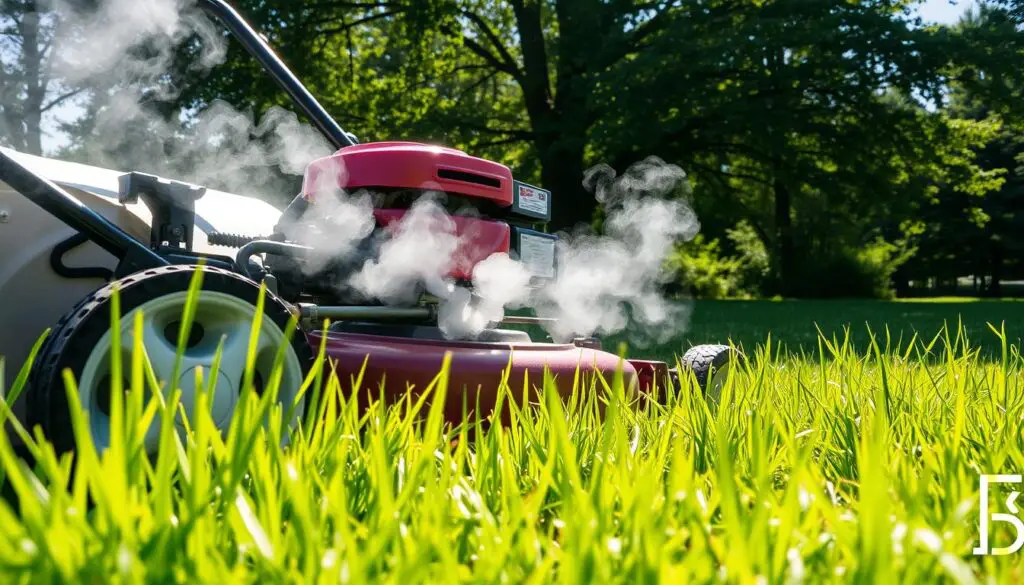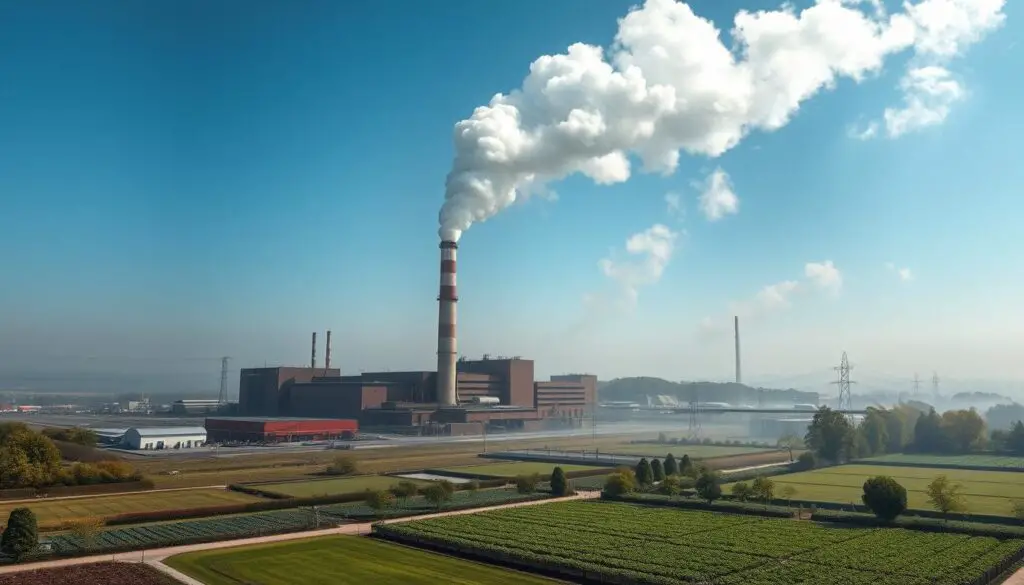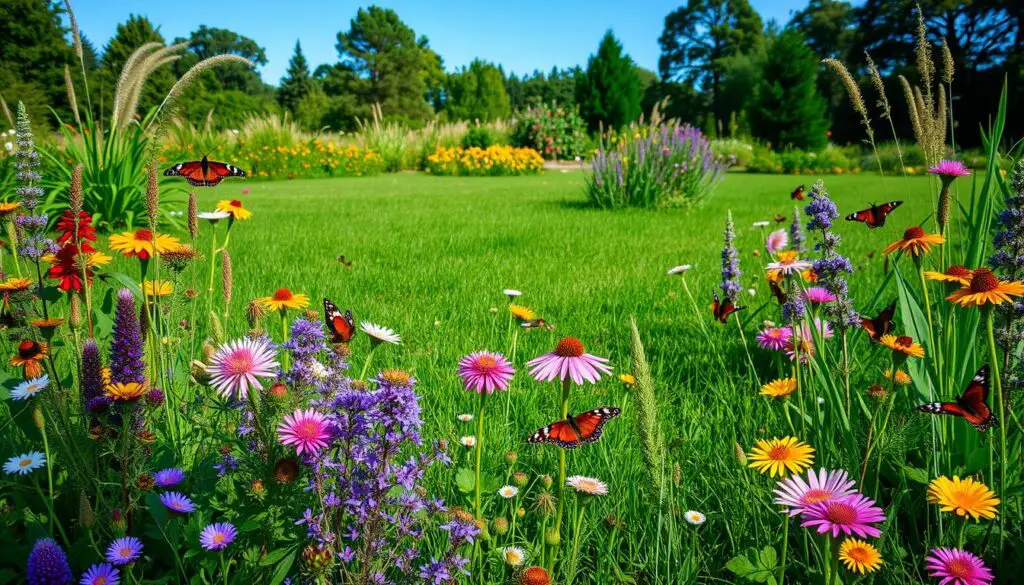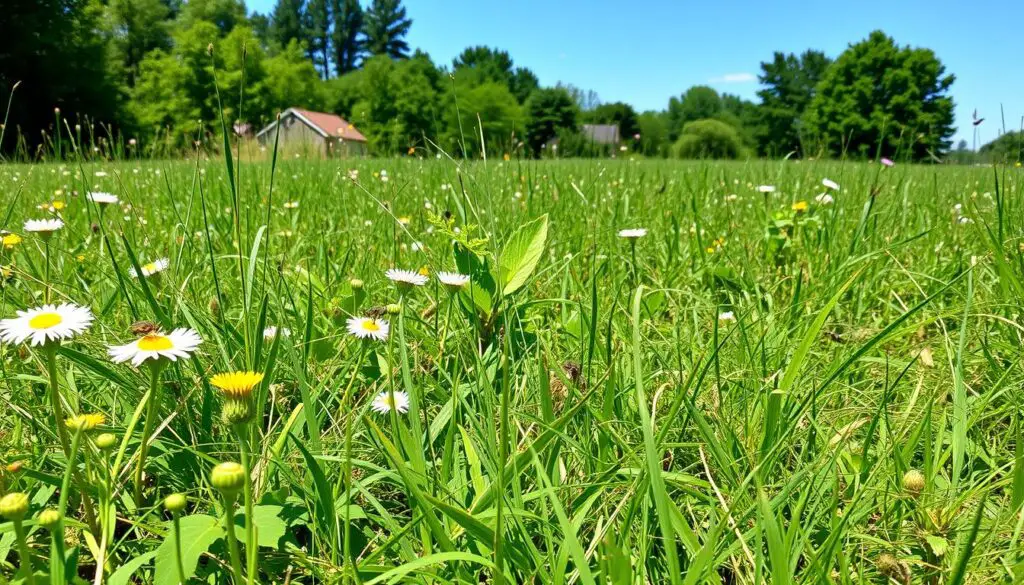The Environmental Impact of Lawn Care Practices

Did you know over 40 million acres in America are covered by lawns? These green spaces may look peaceful, but they have a big environmental cost. The use of gas-powered tools and synthetic fertilizers can harm our planet.
As someone who cares about the environment, I’ve learned about the hidden costs of a perfect lawn. The search for a weed-free yard can hurt our planet. But, there are eco-friendly lawn care, organic lawn care, and sustainable lawn maintenance options. These can help us make our lawns better for the environment and lower our carbon footprint.
Key Takeaways
- Lawns cover over 40 million acres in the U.S., potentially contributing to climate change through maintenance practices.
- Gas-powered lawn equipment and synthetic fertilizers are the main culprits in the environmental impact of lawn care.
- Eco-friendly alternatives such as electric lawn tools and organic fertilizers can significantly reduce the carbon footprint of lawn maintenance.
- Rethinking the traditional lawn by incorporating natural lawn treatments, chemical-free grass care, and green lawn solutions can lead to more eco-conscious yard management and low-impact lawn practices.
- Embracing planet-friendly turf maintenance can transform lawns into effective carbon sinks and promote biodiversity.
Introduction: The Hidden Cost of Pristine Lawns
Many American neighborhoods are filled with vast, green lawns. These lawns show a cultural ideal of perfect beauty. But, the cost of keeping these lawns green is huge and often ignored.
The environmental damage from lawns is a big issue. We need to understand this as we face climate change and look for ways to manage our land better.
The Prevalence of Lawns and Their Role in Climate Change
In the United States, over 40 million acres are covered in lawns. Lawns can help by taking in carbon dioxide. But, the cost of keeping them green is too high.
The use of gas-powered lawn tools and synthetic fertilizers harms the environment. This makes lawns a big part of climate change.
The Main Culprits: Lawn Equipment and Synthetic Fertilizers
The main problems with lawns are the emissions from gas-powered tools and the greenhouse gases from synthetic fertilizers. These issues pollute the air, harm ecosystems, and affect water quality.
We need to change how we care for lawns. We must find eco-friendly ways to maintain them. This will help us move towards a more sustainable future.
The Problem with Lawn Equipment
Most lawn care tools run on gasoline, using two-stroke and four-stroke engines. These engines pollute the air and harm the environment. Two-stroke engines, in particular, release toxic gases without lubrication, causing severe damage.
The Emissions from Gas-Powered Equipment
A 2014 study showed that a two-stroke scooter idles 124 times more than a car or truck. Four-stroke engines are better, but still harmful. For example, a lawn mower running for an hour pollutes as much as a car driving 500 miles. This shows the huge environmental cost of gas-powered lawn equipment emissions.
The Environmental Toll of Lawn Equipment Pollution
Lawn care has a big impact on the environment. The industry releases 26.7 million tons of pollutants every year. Gas-powered equipment is responsible for 5% of air pollution in the U.S. Lawn mowers and leaf blowers also cause noise, soil loss, and harm natural habitats.
The issue with two-stroke and four-stroke engine pollution is clear. We must work towards a greener future by changing our lawn care habits. We need to find eco-friendly alternatives to gas-powered tools.

Eco-Friendly Alternatives for Lawn Equipment
Homeowners are looking for ways to lessen their environmental impact. Choosing the right lawn equipment is key. Now, there are eco-friendly options like electric mowers and blowers. These alternatives are clean and efficient, reducing harmful emissions.
The Benefits of Electric Lawn Equipment
Electric mowers and blowers have improved a lot. They last longer and are more affordable. They produce zero direct emissions, making them better for the planet. Plus, they need less upkeep and take up less space than gas models.
Tips for Reducing Emissions from Gas-Powered Equipment
- Mow less often to use gas tools less
- Use newer, more efficient gas cans to cut down on spills and evaporation
- Mow in the evening when it’s cooler to reduce ozone formation
- Use power tools like leaf blowers and trimmers less
Not everyone can afford electric lawn equipment. But, making small changes to how you use gas tools can still help. It can reduce emissions and lessen environmental harm.
“Using a gas-powered lawn mower for an hour produces the same amount of emissions as 11 running cars.”
The Issue with Synthetic Fertilizers
We all want beautiful lawns, but synthetic fertilizers have a big environmental cost. Homeowners use a lot of these fertilizers, about 3 million tons a year. This leads to a lot of greenhouse gas emissions during production.
Every ton of nitrogen made for these fertilizers creates four to five tons of carbon dioxide. This is a gas that traps heat well.
The problem doesn’t stop there. The extra nitrogen in these fertilizers turns into nitrous oxide in the soil. This gas traps heat 300 times more than carbon dioxide. This shows how our lawn care affects the global climate.
The Threat of Nutrient Runoff and Algal Blooms
These fertilizers also harm local water bodies. They cause eutrophication, leading to toxic algal blooms. These blooms can kill fish and harm people’s health.
“Synthetic fertilizers contribute to an excessive thatch layer, impacting saturated hydraulic conductivity, oxygen movement, and water retention in turfgrass surfaces.”
The damage from synthetic lawn fertilizers is clear. They cause greenhouse gas emissions and harm water bodies. We need to find better ways to keep our lawns healthy for our future and the planet.

Natural Alternatives to Synthetic Fertilizers
We all want to protect our planet, and lawn care is a big part of that. Using natural fertilizers instead of synthetic ones is a great step. Organic lawn fertilizers, like compost and seaweed, feed the soil without harming it.
These fertilizers give nutrients slowly, helping grass grow strong and healthy. They don’t pollute the air or water like synthetic ones do. Plus, they make our lawns safer for kids and pets.
Letting grass clippings stay on the lawn is another smart move. It adds nitrogen and helps the soil. This method, called “grasscycling,” means you don’t need extra fertilizers. It also makes the soil better over time.
When picking an organic fertilizer, look at what it has in it and how it works. NaturaLawn® of America makes special blends that help plants stay healthy. These blends have conditioners and microbes that support plant growth.
“Organic lawn care aims to reduce dependence on synthetic fertilizers, pesticides, and herbicides by fostering a thriving soil ecosystem.”
Choosing organic lawn care makes our lawns green and healthy. It’s good for the planet and keeps our families safe. It’s a win-win for everyone.
Rethinking the Traditional Lawn
The traditional American lawn is common in suburbs and cities. Yet, its environmental effects are often ignored. Lawns look nice but harm the environment. We can change this by choosing greener options for our yards.
The Potential of Lawns as Carbon Sinks
Lawns can actually help the environment by acting as carbon sinks. They absorb carbon dioxide better than many natural areas. But, the harm from lawn care, like gas-powered tools and chemical fertilizers, might outweigh this benefit.
Embracing Biodiversity and Sustainability
We need to rethink our lawns for a better future. Instead of just grass, we can use native plants and other low-care options. These choices help our environment and support local wildlife.
- Xeriscaping: Replacing grass with drought-resistant, native plants that require less water and maintenance.
- Ground Covers: Lush, low-growing plants that create a carpet-like appearance with minimal upkeep.
- Artificial Turf: Replicating the look of a traditional lawn without the need for water, mowing, or fertilizing.
- Hardscaping: Incorporating paved areas, pathways, and other features to reduce the overall lawn size.
- Edible Landscaping: Integrating a variety of edible plants, including fruits, vegetables, and herbs, into the landscape.
- Native Plant Gardens: Cultivating gardens that showcase indigenous flora, which require less water and chemical inputs.
By choosing these alternatives, we can make our yards beautiful and eco-friendly. They help our environment and support local wildlife.
Eco-friendly Lawn Care: Steps to a Sustainable Landscape
We can turn our lawns into vibrant, sustainable spaces. Replacing traditional grass with native plants and alternatives is a big step. These options are better for our local climate and need less water and care.
Replacing Grass with Native Plants and Alternatives
In dry areas, xeriscaping with native plants is a big change. These plants fit well in our environment, needing less water and care. Native grasses, like bunch grass, make a lush lawn that uses much less water than regular turf.
Introducing Edible Plants and Sustainable Landscaping Materials
We can also make our lawns more eco-friendly by adding edible plants. Vegetables, herbs, and fruit trees and shrubs are great choices. They give us fresh food and cut down on lawn space. Mulch, rocks, and other materials also help save water and reduce upkeep, making our landscapes greener.
| Eco-Friendly Lawn Care Practices | Benefits |
|---|---|
| Replacing grass with native plants | Reduced water usage, lower maintenance requirements |
| Incorporating edible landscaping | Sustainable food production, reduced lawn footprint |
| Using sustainable landscaping materials | Lower water needs, decreased maintenance |
By using these eco-friendly lawn care methods, we can make our landscapes beautiful and sustainable. They not only improve our homes’ looks but also help the environment. Let’s change the traditional lawn idea and work towards a greener future.

“Sustainable landscaping is not just about aesthetics – it’s about creating a healthier, more resilient ecosystem that benefits both our homes and the planet.”
The No-Mow Movement: Transforming Lawns
More homeowners are joining the no-mow movement. They’re changing their lawns into sustainable and diverse spaces. This can mean letting grass grow wild, planting low-growing grasses, or using native plants and edible landscaping. But, they face legal and social hurdles like local rules and homeowner association restrictions.
Strategies for Lawn Conversion
To tackle these issues, homeowners might need to change community policies and teach neighbors about sustainable lawns. Some good ways to convert lawns include:
- Letting grass grow wild without mowing
- Planting drought-resistant grasses
- Using native plants and edible landscaping
- Creating intentional designs for post-lawn areas
Overcoming Legal and Social Obstacles
Despite the benefits, some homeowners face opposition from local authorities and neighbors. Old laws and rules might limit lawn changes. To get past these hurdles, homeowners can:
- Push for policy updates, like new ordinances
- Teach neighbors about the benefits of natural landscapes
- Work with local authorities to find solutions that meet everyone’s needs
By embracing the no-mow movement, homeowners can greatly reduce their community’s environmental impact. They promote sustainable landscaping practices.

| Key Lawn Conversion Statistics | Value |
|---|---|
| Lawns cover 2% (40 million acres) of land in the US | 40 million acres |
| Lawns consume nearly 3 trillion gallons of water a year | 3 trillion gallons |
| Lawn care practices consume 200 million gallons of gas annually | 200 million gallons |
| 70 million pounds of pesticides are used on lawns every year | 70 million pounds |
“The no-mow movement is expected to take place over the next 10 to 15 years.”
The Way Forward: Embracing Sustainable Lawn Practices
Climate change is making traditional lawn care harder. As a homeowner, I think it’s time to switch to sustainable lawn care. This means using less water, cutting down on emissions, and using fewer chemicals.
By choosing native plants and low-maintenance options, I can help my local ecosystem. I can also make my lawn edible, which is good for the environment. This change will help my lawn and the planet.
There might be legal and social hurdles, but I’m ready to work with my community. I want to make eco-friendly lawn care the standard. By talking about the benefits, like saving water and supporting wildlife, I hope to inspire others.
The future of lawn care is green. By using sustainable methods, I can make my lawn healthier and help the planet. It’s time for us to take action and make our neighborhoods greener.

